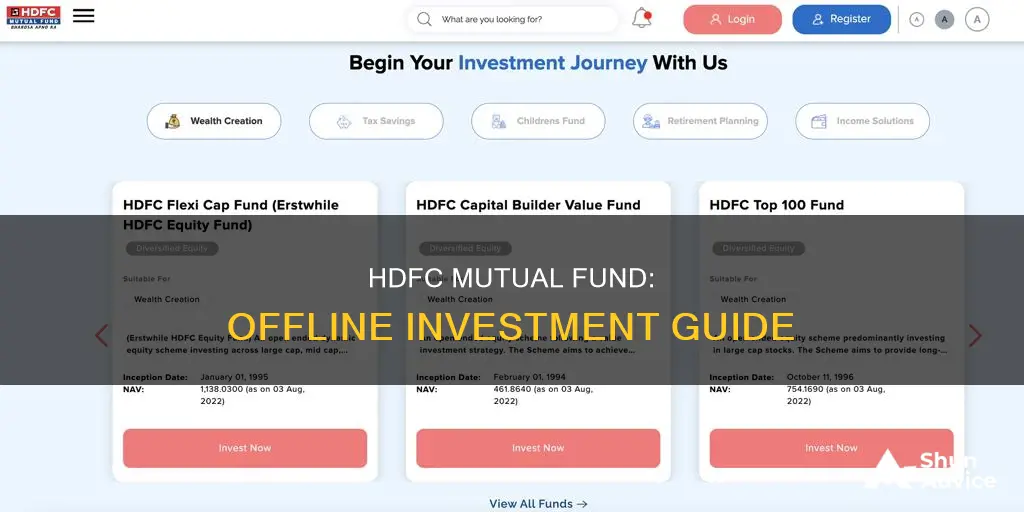
Investing in mutual funds is a great way to create long-term wealth and achieve financial goals. HDFC Mutual Fund is the largest mutual fund and actively managed equity mutual fund in India. It is one of the most profitable asset management companies in the country, managing assets worth Rs. 6.1L Crore as of Mar 31, 2024.
If you're interested in investing in HDFC Mutual Fund offline, you can do so by visiting a branch or office of an intermediary such as HDFC Bank, filling out a simple form, and choosing the fund you want to invest in. You will need to have completed your Central Know Your Customer (CKYC) requirements and submitted the FATCA form or completed it online.
Before investing, it's important to consider factors such as risk versus return, growth vs dividend, and lump sum versus SIP. It's also essential to decide whether you want to invest directly with the Mutual Fund company or through an intermediary.
| Characteristics | Values |
|---|---|
| Types of Mutual Funds | Debt Funds, Equity Funds, Balanced Funds, Large Cap Fund, Mid-Cap Funds |
| Growth vs Dividend | Growth option reinvests dividends; Dividend option pays out dividends |
| Lump Sum vs SIP | Lump sum for ready cash; SIP for small amounts and better cash utilisation |
| Online vs Offline | Online investment possible after CKYC; Offline investment possible through intermediaries like HDFC Bank |
| Direct vs Regular | Direct investment = no commission; Regular investment = more choices, single account management |
| How to find the right fund | Compare returns and rankings online; Get expert recommendations |
| Prerequisites | Permanent Account Number (PAN), bank account, CKYC, FATCA form |
| Offline Process | Visit a branch or office of the intermediary, fill a form and invest |
| SIP Investments | Fill a SIP form with instalment details and submit with a cheque for the first instalment |
What You'll Learn

Complete the one-time identity verification process
To complete the one-time identity verification process, you will need to comply with Know Your Customer (KYC) requirements. This involves submitting a KYC application form and providing proof of identity and address. You will also need to submit the FATCA form or complete it online.
If you are a customer of HDFC Bank, you can complete your Central KYC (CKYC) requirements online. Once you have done this, you can invest in HDFC Mutual Funds online.
If you are not a customer of HDFC Bank, you can still invest in HDFC Mutual Funds offline. To do this, you will need to fill out an investment application form. You can visit a branch or office of an intermediary (such as HDFC Bank), fill up a simple form, and invest in the Mutual Fund of your choice.
Maximizing Investment Returns: Strategies for Utility-Focused Investors
You may want to see also

Choose between lump sum and SIP investment
When deciding between a lump sum and SIP investment, it is important to consider your investment profile, including your income, expenditures, risk profile, and financial goals.
Lump Sum Investment
Lump sum investments are one-time investments where you pay the entire amount at once. This investment strategy is generally preferred by experienced investors with a high-risk tolerance and is chosen when the market is bearish. It is also a good option if you have a considerable amount of money at your disposal. However, you need to be aware of market cycles or trends to identify the right time to invest.
SIP Investment
SIP (Systematic Investment Plan) is a way of investing in mutual fund schemes where you invest a set amount at regular intervals rather than a larger lump sum amount at one time. This strategy is beneficial if you do not have a large amount to invest and want to inculcate a savings habit. It is also ideal for budding investors as it allows you to gain exposure to equities with a nominal amount. SIPs are beginner-friendly and benefit you in both bearish and bullish markets through rupee cost averaging.
Choosing Between the Two
If you have a considerable amount to invest and are experienced in investing, a lump sum investment may be suitable. On the other hand, if you are just starting your investment journey or prefer to invest smaller amounts regularly, SIP is a better option. Additionally, consider the type of fund (equity, debt, or hybrid) and your short-term and long-term goals when making your decision.
Ethical Investment: Where to Place Your Money
You may want to see also

Visit a branch or office of the intermediary
If you want to invest in HDFC Mutual Funds offline, you can visit a branch or office of the intermediary, such as HDFC Bank. Here is a step-by-step guide on how to do this:
- Visit the nearest HDFC Bank branch or office.
- Fill out a simple investment application form. This form will require you to provide personal information, such as your name, address, and financial details. Make sure to carefully review the form before submitting it.
- Choose the HDFC Mutual Fund scheme you want to invest in. Research and consider your financial goals, risk appetite, and the type of fund (e.g., equity, debt, or hybrid funds) that aligns with your investment strategy.
- Decide on the amount you want to invest. You can choose to invest a lump sum amount or opt for a Systematic Investment Plan (SIP), where you invest smaller amounts at regular intervals.
- Provide the necessary documentation. This typically includes proof of identity and proof of address. Ensure that you have all the required documents with you when visiting the branch.
- Submit the completed form and required documents to the bank official. They will guide you through the process and provide you with further instructions, if any.
- For SIP investments, you will need to fill out an additional SIP form. This form will specify the number of instalments, the amount of each investment, and the dates of investment. Submit this form along with a cheque for your first instalment.
- For subsequent SIP instalments, you can set up an ECS (Electronic Clearing Service) mandate. This allows future instalments to be automatically debited from your bank account on the specified dates.
Remember to carefully review the terms and conditions of your chosen HDFC Mutual Fund scheme before finalising your investment. Investing in mutual funds carries market risks, so be sure to consider your financial situation and objectives before proceeding.
Hedge Funds: Risky Business and Unnecessary Investment
You may want to see also

Fill out a simple form
To invest in HDFC Mutual Fund offline, you can visit a branch or office of the intermediary (like HDFC Bank), fill up a simple form, and invest in the Mutual Fund of your choice.
For Systematic Investment Plan (SIP) investments, you will need to fill out a SIP form. This will require you to mention the number of instalments, the amount of investment, and the date of investment. Submit this form along with a cheque for your first instalment. For the rest of the instalments, you can issue an ECS mandate, and future instalments will automatically be debited from your account.
Before investing in HDFC Mutual Fund offline, consider the following factors:
- Risk versus return: Decide on the Mutual Funds you want to invest in based on your financial goals and risk appetite. Different types of Mutual Funds, such as Debt Funds, Equity Funds, and Balanced Funds, offer varying levels of risk and potential returns.
- Growth vs Dividend: Choose between reinvesting dividends for growth or receiving them as income.
- Lump sum versus SIP: Determine whether you want to invest a lump sum or through a SIP, which allows you to invest smaller amounts regularly.
- Direct or Regular: Decide if you want to invest directly with the Mutual Fund company or through an intermediary like HDFC Bank. Investing directly may offer lower fees, while an intermediary provides more choices and easier fund management.
Liquid Fund Investment: Axis Liquid Fund Guide
You may want to see also

Submit a SIP form
To submit a SIP form for an HDFC mutual fund offline, follow these steps:
First, decide on the Mutual Fund you want to invest in based on your financial goals and risk appetite. HDFC offers Equity funds, Debt funds, floating-rate debt, and balanced funds, each with a different risk-return profile.
Next, determine whether you want to receive dividends or choose the growth option. If you opt for dividends, the declared dividends will be paid out to you. If you select the growth option, any dividends will be reinvested in the fund to grow your capital.
Then, decide on the number of instalments, the amount of investment, and the date of investment for your SIP. You can start investing with a small amount, as low as Rs.1000 per month, and benefit from rupee cost averaging.
After you've decided on the details of your SIP, fill out the SIP form, indicating the number of instalments, the amount you wish to invest, and the date of investment. Submit the completed form along with a cheque for your first instalment to an HDFC branch or office. For subsequent instalments, you can set up an ECS mandate to automatically debit the amount from your account.
By submitting a SIP form, you can start investing in HDFC mutual funds offline, benefiting from the flexibility, diversification, and professional management that mutual funds offer.
Schwab S&P 500 Index Fund: A Smart Investment Choice
You may want to see also
Frequently asked questions
You will need a Permanent Account Number (PAN) and a bank account. You also need to complete your CKYC (Central Know Your Customer) process and submit the FATCA form online or in paper form.
If you want to invest offline, you can visit a branch or office of an intermediary (like HDFC Bank), fill out a simple form, and invest in the Mutual Fund of your choice.
For SIP investments, fill out an SIP form mentioning the number of instalments, the amount of investment, and the date of investment. Submit this along with a cheque for your first instalment. For subsequent instalments, you can issue an ECS mandate, and future instalments will automatically be debited from your account.
Investing in HDFC Mutual Fund offline gives you access to expert recommendations based on your financial goals and risk appetite. It also allows you to invest in a wide range of Mutual Fund schemes, providing a comprehensive and flexible way to create a diversified portfolio.







